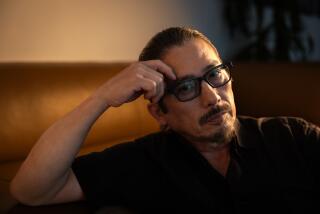STAGE REVIEW : Grand Kabuki of Japan Examines Conflict of Duty vs. Honor
- Share via
The Grand Kabuki Theatre of Japan turned to two serious works of conflict and ethical tension Tuesday and Wednesday at the Japan America Theatre. The company had opened its Southern California appearances with comic works over the weekend in Orange County.
Both works, “Kanjincho (The Subscription Scroll)” and “Osome Hisamatsu Ukina no Yomiuri” (subtitled “Osome no Yonyaku”: Osome’s Four Characters), provided expected--and lavishly fulfilled--virtuoso opportunities for the central characters.
But both also shared the ethical dilemma of conflict between duty and emotion, which could be resolved only by sacrificing the self.
An 19th-Century adaptation on the classical Noh drama “The Barrier at Ataka” by Namiki Gohei III, “Kanjincho” provides an extraordinary range of demands and opportunities to the central figure, the loyal warrior Benkei, here played by the formidably accomplished Kichiemon Nakamura II.
As Benkei, Kichiemon was strong, courageous, clever, quick-witted, deceptive, prudent, a leader of men and a drinker of enormous appetite. He had dazzling stamina; of course, he was able to dance.
The plot concerns Benkei’s successful effort to get his lord--the young hero Yoshitsune--safely through a pass guarded by enemies. To accomplish this feat, he and the lord’s followers have adopted the disguise of mountain priests and dressed the lord as their servant.
But to persuade a skeptical border guard that Yoshitsune is indeed a servant, Benkei ultimately must strike him, an unimaginable breach of ethics for which Benkei expects no forgiveness.
Kichiemon, who had played the jealous wife in “Migawari Zazen (The Substitute Meditator)” and the venerable but vulnerable priest in “Narukami (The Thunder God)” in Costa Mesa, triumphed in the demands. Ranging from towering strength to abject humiliation, from wise reflection to unbuttoned intoxication, he commanded constant attention.
He was no less impressive in movement terms, whether in weighty dances expressing lament for the fate of warriors or joyful honor toward his opponent, or in his final bounding exit.
Sojuro Sawamura IX, however, provided the most astonishing contrast in characters portrayed in the two Southland cities. As the nimble, impish philandering husband in the farcical “Migawari Zazen” in Costa Mesa, Sojuro scarcely prepared us for the noble dignity and spiritual generosity of his Togashi, the border guard in “Kanjincho.”
Sojuro let us know that Togashi sees through the deception. But equally clearly, he showed us that Togashi so deeply comprehends Benkei’s loyalty to his master that he will allow the party to pass.
But he showed that the decision was made under enormous strain and at ultimate cost: We realize at the end that Togashi believes he can pay for his disloyalty to his lord only by killing himself.
When, in their last moments together, the two men strike classic Kabuki poses simultaneously, they established a memorable juxtaposition of the demands of duty and the demands of inner emotion, of transcending and yet affirming the unbreakable moral code.
Kasho Nakamura III was a dignified Yoshitsune. A naguata ensemble led by Richo Tobaya and Shojiro Keneya provided refined, but powerful accompaniment.
“Osome no Yonyaku” is the final scene of an 1813 Kabuki adaptation of a Bunraku puppet theater play by Hanji Chikamatsu.
As such, the ethical tensions of the play--it involves murder, abandonment and betrayal but ends happily--could seem attenuated and easily overshadowed by the rapid costume changes of the onnagata (specialist in women’s roles) Kotaro Nakamura V.
Kotaro deftly portrayed four different characters: a pair of lovers bent on suicide; the mad, abandoned fiancee; and the wicked mistress of an enemy of the lovers.
In a pas de deux in which he played both male and female parts, Kotaro switched so quickly between roles one was amazed. But it was as the distraught Omitsu that he had sufficient opportunity to project a developed character, full of conflict. Coy flirtation, anxiety, vacancy, longing and a host of other emotions flickered over his expressive face. A remarkable performance.
More to Read
The biggest entertainment stories
Get our big stories about Hollywood, film, television, music, arts, culture and more right in your inbox as soon as they publish.
You may occasionally receive promotional content from the Los Angeles Times.










